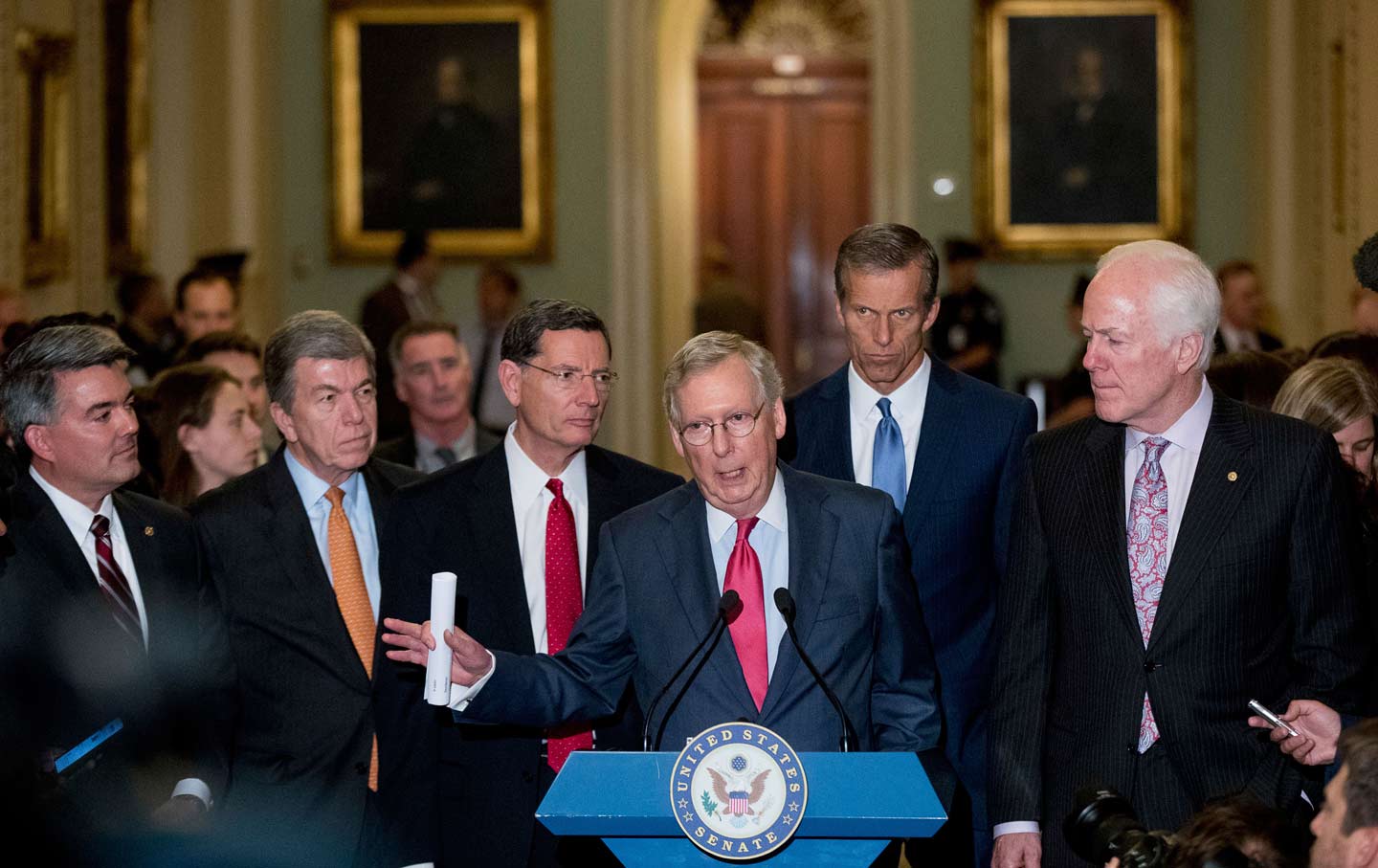Most Recent
This F*cking Guy Started a Harmful Trade War
Six years ago today, Trump announced tariffs of 25 percent for foreign-made steel and 10 percent for aluminum. The policy was an escalation of his harmful trade war which left lingering, dangerous effects on the American economy. American companies paid the price for Trump’s trade war. Between 2018 - 2020, Trump’s tariffs cost American companies an estimated $46 billion. Trump’s tariffs forced American importers to drive…
Trump's Tax Plan Is Extremely Dangerous
Trump’s tax plan “would make the national debt skyrocket by $10 trillion or more.” Moody’s Analytics found that Trump’s tax reform proposal…
WATCH: Trump's Trade Hypocrisy
Donald Trump says there shouldn't be a federal minimum wage, but tries to portray himself as a champion of working families. Trump's…
Any Port in a Storm? Portman Seeks Refuge from Record of Outsourcing American Jobs
If Rob Portman wants to remind us what a patent failure he was as United States Trade Representative under President George W. Bush, he's doing a "heckuva job." Portman is in the fight of political life this election cycle and he's making sure the hardworking men and women of Ohio know that he's on their side by cracking down on currency manipulation. “It is critical that any new trade agreement include effective tools to fight back against a practice that has resulted in the loss of millions of American jobs,” said Portman in a statement. It sure sounds like a reasonable message, if you completely ignore the messenger. Portman simply has no standing to talk about protecting American workers.
Mitt Romney's Five-Point Plan
Energy Independence
Romney’s Five Point Plan Included North American Energy Independence. According to The Los Angeles Times, “Achieve North American energy independence by increasing access to domestic fossil fuels, streamlining regulations and the permitting process, drilling offshore and in the Arctic National Wildlife Refuge, and approving the Keystone oil pipeline from Canada. ‘No. 1, we’re going to take advantage of our energy, and that’s going to create millions of jobs.’” [The Los Angeles Times, 9/15/12]Romney Supports Ideas Similar To President Obama
Romney And Obama Had Similar Energy Plans Favoring Expanding Drilling And Natural Gas Development. According to The Washington Post, “Here are some of the highlights of the energy positions of Mitt Romney and President Obama. There are similarities. Both candidates favor expanded oil and gas drilling and support the development of natural gas resources, even with the use of controversial hydraulic fracturing techniques. Obama says he favors an ‘all of the above’ strategy and wants to further reduce U.S. reliance on foreign oil. Romney says he would aim for ‘North American energy independence,’ leaning heavily on increased imports from Canada and higher U.S. output.” [The Washington Post, 9/11/12]Romney Supports Ideas Benefitting Wealthy Oil Companies
Central Part Of Romney’s Energy Plan Is Deregulating Oil And Gas Industry. According to Huffington Post, “A central part of the plan is taking the power to permit and license new onshore drilling on federal lands out of the hands of the federal government and putting it into the hands of the states. That means that states like Alaska or North Dakota, which is enjoying a massive oil boom under the current regulatory regime, would be able to allow drilling on federal lands with no oversight from Washington. North Dakota stands out, in particular, as it is where Romney’s top energy adviser, oil billionaire Harold Hamm, is making his fortune. Hamm, whose stump speech is only three words, ‘Beat Barack Obama,’ has given $985,000 to Restore Our Future and raised money for the Romney campaign. He would profit greatly from this change in policy as his company, Continental Resources, would be freed to drill beyond the Bakken fields in North Dakota using techniques including hydraulic fracking and horizontal drilling.” [Huffington Post, 8/24/12]Improve Education
Romney’s Five Point Plan Included Improving Education Through School Choice And Changing Teacher Hiring. According to The Los Angeles Times, “Improve education and job training, in part by increasing school choice and changing the way teachers are hired and evaluated. ‘We’ve got fix our schools.... It’s time for us to put the kids and the parents and the teachers first, and the teachers union behind.’” [The Los Angeles Times, 9/15/12]Romney Deferred Education Funds To States For Private School Vouchers
Romney’s Education Policy Gave Federal Funds To States But Did Not Force Or Encourage Them To Expand School Choice. According to a Time op-ed, “Romney and other Republicans know they’re using a great talking point when they complain that the President is against allowing poor kids in Washington’s beleaguered public schools to attend better schools, especially when Obama’s own kids attend a highly-regarded private school in the city. But as policy, Romney’s blueprint is pretty weak soup because it doesn’t force — or even do much to encourage — states to expand choice. It merely says that federal dollars will defer to states and cities that decide to allow private-school vouchers.” [Time, Op-Ed, 6/14/12] Romney’s Education Policy Was Similar To “Pro-Voucher” Report From The Hoover Institution. According to The New York Times, “Mr. Romney’s policy seems closely inspired by a pro-voucher report issued in February by the conservative Hoover Institution. Five of eight members of a task force that produced the report are among the 19 education advisers the Romney campaign named last month. Once thought to be moribund, the voucher movement was revived by gains Republicans made in the 2010 midterm elections. Fourteen states since then have introduced or expanded private school vouchers, according to the Friedman Foundation for Educational Choice.” [The New York Times, 6/11/12]Romney’s Open-Enrollment Mandate For School Districts Were More Burdensome Than No Child Left Behind
Romney’s Open-Enrollment Requirement Had “Massive” Loophole Because Transfer Student Capacity Could Not Be Easily Verified. According to a Time op-ed, “There’s a massive loophole that lets everyone off the hook. The one tantalizing part of Romney’s proposal is his requirement for states to adopt open-enrollment policies that disregard school-district boundaries for public schools. That would be a big deal for poor parents. Open enrollment in theory would give inner-city kids and other kids stuck with lousy school options the chance to attend better public schools elsewhere. But there are two problems. First, as my former colleague, Erin Dillon, showed in a 2008 Education Sector analysis, there are just not enough good schools within a reasonable distance for these kids to commute to. Romney’s proposal also leaves a loophole wide enough to render the open-enrollment provision meaningless because it hinges on schools having sufficient ‘capacity’ to accept transfer students. That’s the same hazard that doomed No Child Left Behind’s public-school choice provisions. Don’t want students transferring in? Then make sure you have no capacity, a metric that is difficult to verify.” [Time, Op-Ed, 6/14/12] Romney’s Open-Enrollment Policy Would Require A “More Invasive Mandate” On States Than No Child Left Behind. According to a Time op-ed, “And in case you slept through the last several years, Republicans are against heavy-handed federal intervention in schools right now. They want to scrap the 10-year-old No Child law, which merely required states to come up with school accountability systems. It’s politically inconceivable that a President Romney would replace that law with a much more invasive mandate on states to essentially scrap school district boundaries and have a federal hand in deciding which students get to attend which schools.” [Time, Op-Ed, 6/14/12] Read the full report after the jump.BRIDGE BRIEFING: Ryan And Trade
Ryan Opposed Efforts To Punish China For Currency Manipulation
In 2010, Ryan Opposed The “Currency Reform Fair Trade Act” To Impose Tariffs On Countries With Undervalued Currencies. According to the Boston Globe, “In 2010, when the House voted on the Currency Reform Fair Trade Act, Ryan was among the 79 congressmen who opposed the measure. The bill passed – 348 to 79, with 99 Republicans voting in favor – but was not taken up by the Senate so it never became law. The legislation would have given the president expanded authority to impose tariffs on the imports from countries that have ‘fundamentally undervalued’ currencies.” [Boston Globe, 8/16/12]Oops… Romney Venue Benefited From Obama Admin's Actions Toward China
At his event at American Spring Wire in Ohio today, Romney repeated his pledge to crack down on China. As you know, his campaign has routinely attacked the Obama administration over this very issue. Unfortunately for Romney, though, American Spring Wire actually petitioned the Obama administration for help dealing with China... then got exactly what they wanted.
Research below:
In June 2009, American Spring Wire Petitioned The U.S. Department Of Commerce To Investigate Countervailing Duties And Antidumping On Steel Wire Imports From China.According to a press release from the U.S. Department of Commerce’s International Trade Administration, obtained via Targeted News Service, “On June 17, the Department of Commerce (Commerce) announced its decision to initiate antidumping and countervailing duty investigations on imports of certain prestressed concrete steel wire strand from the People’s Republic of China (China). Dumping occurs when a foreign company sells a product in the United States at less than normal value. Subsidies are financial assistance from foreign governments that benefit the production, manufacture, or exportation of goods. The petitioners for these investigations are American Spring Wire Corp. (OH), Insteel Wire Products Company (NC), and Sumiden Wire Products Corp. (TN). The merchandise covered by these investigations consists of certain prestressed concrete steel wire strand which is a collection of wire rod bars, typically covered with an epoxy material and is primarily used in concrete construction applications. The merchandise covered by these investigations is currently classified in the Harmonized Tariff Schedule of the United States (HTSUS) under item numbers: 7312.10.3010 and7312.

